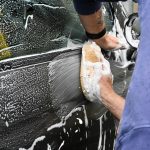Mastering the Art of Hand Washing Your Car: Techniques for a Spotless Exterior
Headlight Maintenance
Maintaining clear and bright headlights is crucial for safety and aesthetics. This section covers two essential techniques: restoring cloudy headlights and using a renewal kit effectively.
Restoring Clarity to Headlights
Over time, headlights can become cloudy or yellowed due to exposure to UV light, harsh weather, and road debris. Restoring them to their original clarity not only improves visibility but also enhances the vehicle’s appearance.
To restore clarity, start by cleaning the headlights with a gentle automotive soap and water to remove any dirt and debris. Once clean, apply a mixture of baking soda and vinegar using a microfiber cloth. Gently rub the solution in circular motions, focusing on the most affected areas.
Rinse thoroughly with water and dry with a clean cloth. Finish by applying a UV sealant, which will help protect the headlights from further damage and maintain their clarity. This method can significantly improve visibility during night driving while also giving a polished look to the car’s exterior.
Using a Headlight Renewal Kit
For those seeking a comprehensive solution, using a headlight renewal kit can make rejuvenating headlights an easier task. These kits usually include several items such as a cleaner, sanding pads, and protection sealant, providing complete guidance through the restoration process.
Begin by following the kit’s instructions to clean the headlights. Use the sanding pads to remove the outer layer of oxidation. This often involves progressively finer grits of sandpaper to ensure a smooth and clear finish.
After sanding, apply the included cleaner to remove any remaining residue. Finally, use the protection sealant provided in the kit to coat the headlights, securing them against future damage. This method not only restores the headlights to like-new condition but also helps ensure they remain clear for an extended period.
Interior Tips and Tricks
Achieving a clean car interior involves efficient vacuuming and cleaning of upholstery. Dust and debris accumulate quickly, so regular care is necessary. Attending to these areas not only enhances aesthetic appeal but also ensures a healthier driving environment.
Vacuuming and Dusting
Vacuuming is crucial for a spotless car interior. Start by removing floor mats to access all areas. Use a vacuum with multiple attachments to reach crevices, under seats, and between cushions. A narrow nozzle attachment is ideal for tight spots, while a brush attachment helps dislodge dirt from fabric surfaces.
Address the seats, floor, and trunk, ensuring all debris is captured. Dusting hard surfaces like the dashboard completes the task. Use a microfiber cloth to gently remove accumulated dust, tackling the steering wheel, air vents, and console. Regular vacuuming and dusting maintain cleanliness and prevent dust build-up that can compromise air quality.
Cleaning Upholstery and Surfaces
Upholstery requires different techniques based on the material. For fabric seats, use a fabric cleaner or a mild detergent. Lightly spray the solution and scrub with a soft brush, then blot with a clean cloth to remove moisture. For leather, use a leather cleaner followed by a conditioner to maintain its suppleness and shine.
Clean the dashboard, console, and door panels with appropriate surface cleaners. A damp microfiber cloth can remove most dirt without leaving scratches. Pay attention to cup holders and storage compartments, as these areas tend to gather sticky residues. Proper care of the upholstery and surfaces ensures a pleasant interior free from dirt and stains.



